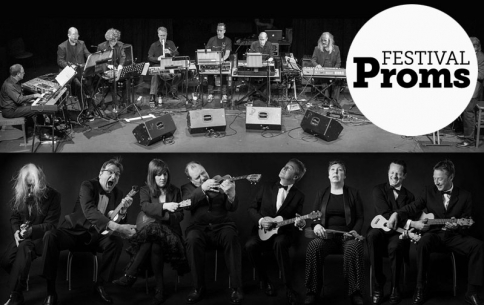
at the Town Hall on 9th July.
Now, on the face it there would seem little connection between the humble ukulele and old analogue Moog synthesisers – and none at all with Erik Satie who is the thread running through the Festival. Satie we’ll come to in a minute but there are undoubted similarities between the two instruments. The one is for (forgive me) nerds who think they can become a musician for an outlay of £19.99 and the other for nerds who yearn for the good old days of electronic music. However, the two instruments have a lot in common and their pairing for this concert was inspired.
So, apart from the perceived nerdiness, what do they have in common? Well, obviously there is the hint of eccentricity but, more fundamentally they are both, in their own ways, fairly basic musical instruments. The old analogue Moogs, despite their electronic wizardry, can only play one note at a time and the sounds they make basically boils down to that of either an electronic comb and paper or a high-pitched, pulsating whistle. I exaggerate and don’t do them justice, but they are certainly a million miles away from current state-of-the-art digital synths. The ukulele, apart from the kazoo, is about as low down the musical instrument chain as you can get and its ubiquitous rise in popularity over the past few years bears this out with myriad bands, clubs and festivals giving it a bad name. But it is the debunking of the perceived limitations of the instruments which makes the Will Gregory Moog Ensemble and the Ukulele Orchestra of Great Britain so appealing.
The ten-piece synth band played everything from Bach’s Brandenburgs to the theme music from A Clockwork Orange, complete with Anthony Burgess readings. The richness and variety of sound that the ensemble achieves is remarkable but there is always an inevitable sameness to it. The Satie they played came in the form of an arrangement of Gnossienne No.1. Beautiful though it certainly was, it demonstrated the problem that poor Mr S has with the popularisation of his work and this rendition made his cerebral masterpiece sound like the theme to a TV detective show, almost indistinguishable from that of Midsomer Murders. The band was at its best with dedicated synthesiser music and John Carpenter’s rousing theme from Escape from New York was the most outstanding and successful.
But it was clearly the Ukulele Orchestra of Great Britain the audience had come to see and I have to say that at the end of the Moog set the guy in front of me had his fingers in his ears. The UOGB has been around for a long time and their brand of humour, musicianship and their varied repertoire have made them popular around the world. Formally dressed in black ties for the six men and black dresses for the two ladies they harked back a bit to the likes of the Bonzos or the Temperance Seven.
Each member of the band had their own song which ranged from Joni Mitchell to Prince and the ensemble’s version of to Ennio Morricone theme from The Good, the Bad and the Ugly was almost as good as the real thing with some very fine whistling. But it was the numbers that raised a broad smile that were the best. For me, the highlight of their set, and in fact the evening, was a Russian, balalaika version of George Formby’s Leaning on a Lamp Post, complete with a Red Army choir. It worked brilliantly and was hilarious.
To round off the concert the two bands came together for a spirited rendition of Hawkwind’s Silver Machine. As I said at the beginning, whoever put these two acts together was inspired and the evening really demonstrated that chalk and cheese can, in fact, be complimentary. Loved every minute of it. Michael Hasted

